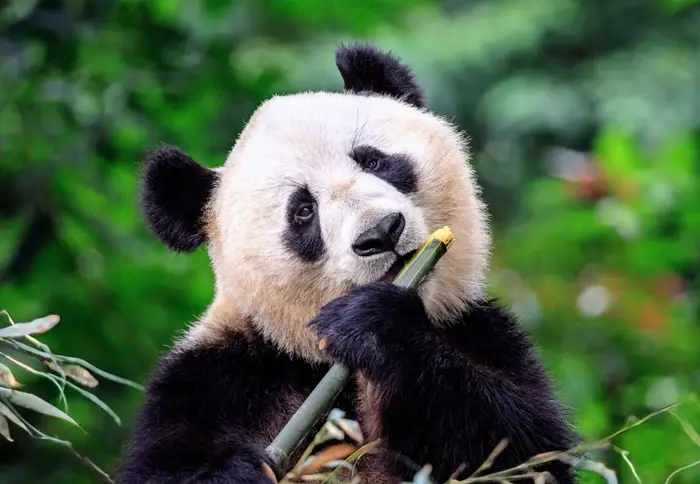Greater than a 3rd of all animals on Earth, from beetles to cows to elephants, dwell on a plant-based weight loss program. Since vegetation are typically low in energy, herbivores already discover it troublesome to acquire the vitality they want.
Now, as local weather change impacts rising situations, a number of the plant-based meals that animals depend upon are shedding a few of their dietary worth.
As a consequence of human actions, the focus of carbon dioxide within the environment continues to extend, inflicting international temperatures to rise. In response, many vegetation in ecosystems world wide are rising quicker.
Some researchers confer with this phenomenon as “greening the planet,” and trapping extra carbon in vegetation might offset a number of the greenhouse fuel emissions.
Nonetheless, there are trade-offs. These fast-growing vegetation typically include fewer vitamins in every chew.
Ellen Welty, together with colleagues on the Smithsonian Establishment, is finding out how this type of nutrient dilution impacts species throughout the meals net, from tiny grasshoppers to massive pandas.
They believe {that a} long-term decline in plant high quality could also be a largely unnoticed issue within the decline in animal populations.
These adjustments in plant diet are neither as apparent as sea degree rise nor as sudden as hurricanes or excessive warmth waves. However, it may possibly have important results over time.
When the dietary worth of vegetation decreases, herbivores might take longer to seek out and devour sufficient meals, making them extra weak to predators and different risks.
Insufficient nutrient consumption can scale back an animal’s health, affecting development, copy, and survival.
Scientists have already proven that local weather change is inflicting a dilution of vitamins in human meals crops.
Decreases in essential micronutrients reminiscent of iron, zinc, magnesium, and copper are of specific concern. Data of crop nutrient content material reveal that these components are lowering over time.
For people, losses in staple iron, zinc, and protein are anticipated to worsen in coming many years as CO₂ concentrations rise.
Such deficiencies might have severe implications for international well being and survival, particularly in areas that rely closely on crops reminiscent of rice and wheat, together with components of East and Central Asia.
The standard of livestock feed can be declining. Cows already spend a major period of time grazing, however getting sufficient protein is turning into more and more troublesome.
Protein concentrations in pasture are lowering throughout rangelands, decreasing animal weight acquire and rising prices for producers. Moreover, wild species will not be resistant to nutrient dilution.
Big pandas, a culturally important and endangered species, rely solely on bamboo.
Pandas are sluggish breeders and require giant, unbroken bamboo forests for habitat, so land conversion for agriculture and improvement is placing their existence in danger.
Pandas may also symbolize the dangers posed by nutrient dilution.
The large panda is taken into account an “umbrella species,” so defending its habitat advantages the various different creatures that share it.
Remarkably, big pandas devour giant quantities of bamboo every single day. Presently, rising temperatures are decreasing the dietary worth of bamboo, making it troublesome for the plant to outlive.
Bamboo is an important useful resource for pandas, so a discount in its vitamins might have an effect on panda well being and inhabitants.
Bugs play an essential function in pollination, function a meals supply for birds and animals, and carry out different ecological features.
Nonetheless, many insect species are declining world wide, together with in locations much less immediately affected by human actions. Adjustments in phytochemistry could also be influencing these declines.
Since many bugs eat vegetation, they are often affected by lowered dietary high quality of vegetation.
Experiments have proven that as carbon dioxide ranges rise, sure insect populations decline, a minimum of partly because of decrease meals high quality.
Nonetheless, not all bugs react the identical means. Bugs that chew on leaves, reminiscent of grasshoppers and caterpillars, are thought of probably the most weak, as they change into smaller and fewer fertile.
Conversely, locusts breed on carbon-rich vegetation and may even thrive underneath situations of excessive carbon dioxide concentrations. Bugs reminiscent of aphids and cicadas that feed on phloem quite than leaves may profit from carbon-rich plant buildings.
Areas which can be already nutrient-poor, reminiscent of the traditional soils of the tropical basins of Australia, the Amazon, and the Congo, would be the most affected, as native animals already battle to acquire ample diet. It is doable.
Quickly rising ocean temperatures have equally lowered the dietary content material of big sea kelp, which serves as an essential meals supply within the open ocean.
Sure herbivores, particularly people who require a high-quality weight loss program, could also be hit tougher. Hindgut-fermenting animals reminiscent of rodents, rabbits, koalas, horses, rhinos, and elephants depend on microorganisms of their intestine to extract vitamins from fibrous plant materials and due to this fact require nutrient-rich feed.
Small animals with quick metabolisms additionally depend on extra nutritious meals and may battle when plant high quality declines.
Extra proof is required to know the function of nutrient dilution in inhabitants decline. This contains synthetic experiments that enhance CO₂ ranges to imitate local weather change, in addition to subject research that observe adjustments in plant chemistry and the impression on wildlife populations.
In the long run, scientists intention to know how lowered plant dietary worth reshapes meals webs. Adjustments in plant species, traits, and interactions can alter relationships between predators, prey, and whole ecosystems.
At a time when local weather change is already straining the planet, nutrient dilution provides a delicate however far-reaching new problem that would change the form of life on Earth.
—–
Like what you learn? Subscribe to our e-newsletter for fascinating articles, unique content material and the newest updates.
Verify us out on EarthSnap, the free app from Eric Ralls and Earth.com.
—–









